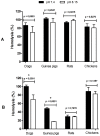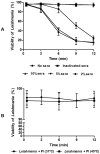Different host complement systems and their interactions with saliva from Lutzomyia longipalpis (Diptera, Psychodidae) and Leishmania infantum promastigotes
- PMID: 24255715
- PMCID: PMC3821853
- DOI: 10.1371/journal.pone.0079787
Different host complement systems and their interactions with saliva from Lutzomyia longipalpis (Diptera, Psychodidae) and Leishmania infantum promastigotes
Abstract
Background: Lutzomyia longipalpis is the vector of Leishmania infantum in the New World, and its saliva inhibits classical and alternative human complement system pathways. This inhibition is important in protecting the insect´s midgut from damage by the complement. L. longipalpis is a promiscuous blood feeder and must be protected against its host's complement. The objective of this study was to investigate the action of salivary complement inhibitors on the sera of different host species, such as dogs, guinea pigs, rats and chickens, at a pH of 7.4 (normal blood pH) and 8.15 (the midgut pH immediately after a blood meal). We also investigated the role of the chicken complement system in Leishmania clearance in the presence and absence of vector saliva.
Results: The saliva was capable of inhibiting classical pathways in dogs, guinea pigs and rats at both pHs. The alternative pathway was not inhibited except in dogs at a pH of 8.15. The chicken classical pathway was inhibited only by high concentrations of saliva and it was better inhibited by the midgut contents of sand flies. Neither the saliva nor the midgut contents had any effect on the avian alternative pathway. Fowl sera killed L. infantum promastigotes, even at a low concentration (2%), and the addition of L. longipalpis saliva did not protect the parasites. The high body temperature of chickens (40°C) had no effect on Leishmania viability during our assays.
Conclusion: Salivary inhibitors act in a species-specific manner. It is important to determine their effects in the natural hosts of Leishmania infantum because they act on canid and rodent complements but not on chickens (which do not harbour the parasite). Moreover, we concluded that the avian complement system is the probable mechanism through which chickens eliminate Leishmania and that their high body temperature does not influence this parasite.
Conflict of interest statement
Figures







Similar articles
-
Binding of Leishmania infantum Lipophosphoglycan to the Midgut Is Not Sufficient To Define Vector Competence in Lutzomyia longipalpis Sand Flies.mSphere. 2020 Sep 9;5(5):e00594-20. doi: 10.1128/mSphere.00594-20. mSphere. 2020. PMID: 32907950 Free PMC article.
-
Immunization of Experimental Dogs With Salivary Proteins From Lutzomyia longipalpis, Using DNA and Recombinant Canarypox Virus Induces Immune Responses Consistent With Protection Against Leishmania infantum.Front Immunol. 2018 Nov 16;9:2558. doi: 10.3389/fimmu.2018.02558. eCollection 2018. Front Immunol. 2018. PMID: 30519235 Free PMC article.
-
Distinct cellular migration induced by Leishmania infantum chagasi and saliva from Lutzomyia longipalpis in a hemorrhagic pool model.Rev Inst Med Trop Sao Paulo. 2014 Jan-Feb;56(1):21-7. doi: 10.1590/S0036-46652014000100003. Rev Inst Med Trop Sao Paulo. 2014. PMID: 24553604 Free PMC article.
-
Lutzomyia longipalpis (Diptera: Psychodidae: Phlebotominae): a review.An Acad Bras Cienc. 2003 Sep;75(3):301-30. doi: 10.1590/s0001-37652003000300005. Epub 2003 Aug 25. An Acad Bras Cienc. 2003. PMID: 12947480 Review.
-
Sand fly saliva: effects on host immune response and Leishmania transmission.Folia Parasitol (Praha). 2006 Sep;53(3):161-71. Folia Parasitol (Praha). 2006. PMID: 17120496 Review.
Cited by
-
Guianensin, a Blackfly Salivary Protein, Inhibits the Lectin Pathway of Complement.J Med Chem. 2025 Feb 27;68(4):4663-4671. doi: 10.1021/acs.jmedchem.4c02704. Epub 2025 Feb 9. J Med Chem. 2025. PMID: 39924859 Free PMC article.
-
The Sand Fly Salivary Protein Lufaxin Inhibits the Early Steps of the Alternative Pathway of Complement by Direct Binding to the Proconvertase C3b-B.Front Immunol. 2017 Aug 31;8:1065. doi: 10.3389/fimmu.2017.01065. eCollection 2017. Front Immunol. 2017. PMID: 28912782 Free PMC article.
-
Amblyomma sculptum Salivary Protease Inhibitors as Potential Anti-Tick Vaccines.Front Immunol. 2021 Feb 4;11:611104. doi: 10.3389/fimmu.2020.611104. eCollection 2020. Front Immunol. 2021. PMID: 33633731 Free PMC article.
-
C-reactive protein binds to short phosphoglycan repeats of Leishmania secreted proteophosphoglycans and activates complement.Front Immunol. 2023 Aug 31;14:1256205. doi: 10.3389/fimmu.2023.1256205. eCollection 2023. Front Immunol. 2023. PMID: 37720216 Free PMC article.
-
Inhibition of the complement system by saliva of Anopheles (Nyssorhynchus) aquasalis.Insect Biochem Mol Biol. 2018 Jan;92:12-20. doi: 10.1016/j.ibmb.2017.11.004. Epub 2017 Nov 8. Insect Biochem Mol Biol. 2018. PMID: 29128668 Free PMC article.
References
-
- Quaresma PF, Rêgo FD, Botelho HA, Silva SR, Moura Júnior AJ et al. (2011) Wild, synanthropic and domestic hosts of Leishmania in an endemic area of cutaneous leishmaniasis in Minas Gerais State, Brazil. Trans R Soc Trop Med Hyg 105: 579: 585. - PubMed
Publication types
MeSH terms
Substances
LinkOut - more resources
Full Text Sources
Other Literature Sources

